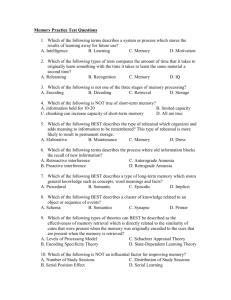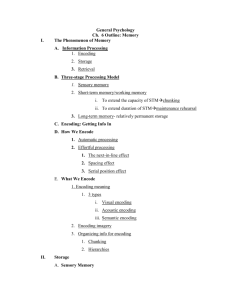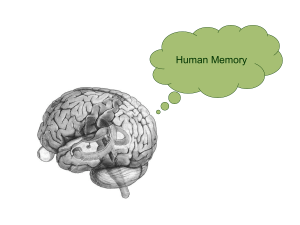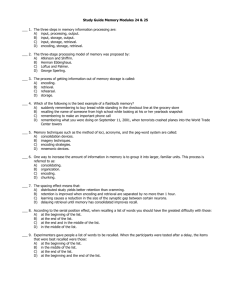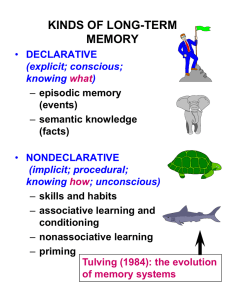AP Ch 7 & 8 Assignment Sheet 2014-15
advertisement
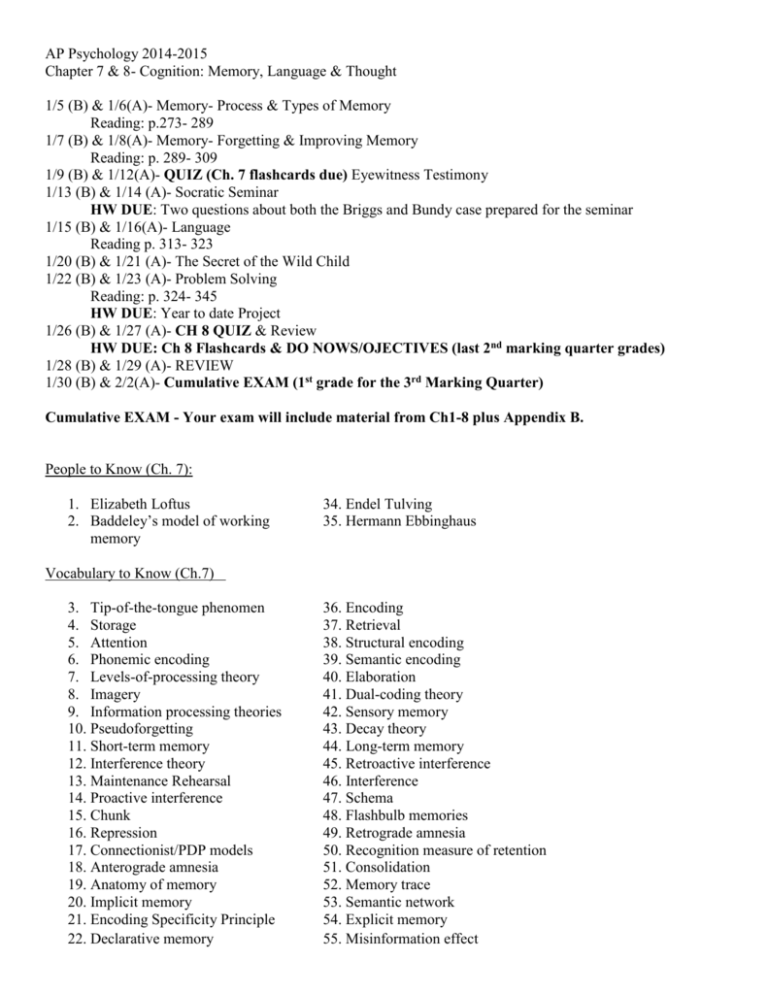
AP Psychology 2014-2015 Chapter 7 & 8- Cognition: Memory, Language & Thought 1/5 (B) & 1/6(A)- Memory- Process & Types of Memory Reading: p.273- 289 1/7 (B) & 1/8(A)- Memory- Forgetting & Improving Memory Reading: p. 289- 309 1/9 (B) & 1/12(A)- QUIZ (Ch. 7 flashcards due) Eyewitness Testimony 1/13 (B) & 1/14 (A)- Socratic Seminar HW DUE: Two questions about both the Briggs and Bundy case prepared for the seminar 1/15 (B) & 1/16(A)- Language Reading p. 313- 323 1/20 (B) & 1/21 (A)- The Secret of the Wild Child 1/22 (B) & 1/23 (A)- Problem Solving Reading: p. 324- 345 HW DUE: Year to date Project 1/26 (B) & 1/27 (A)- CH 8 QUIZ & Review HW DUE: Ch 8 Flashcards & DO NOWS/OJECTIVES (last 2nd marking quarter grades) 1/28 (B) & 1/29 (A)- REVIEW 1/30 (B) & 2/2(A)- Cumulative EXAM (1st grade for the 3rd Marking Quarter) Cumulative EXAM - Your exam will include material from Ch1-8 plus Appendix B. People to Know (Ch. 7): 1. Elizabeth Loftus 2. Baddeley’s model of working memory 34. Endel Tulving 35. Hermann Ebbinghaus Vocabulary to Know (Ch.7) 3. Tip-of-the-tongue phenomen 4. Storage 5. Attention 6. Phonemic encoding 7. Levels-of-processing theory 8. Imagery 9. Information processing theories 10. Pseudoforgetting 11. Short-term memory 12. Interference theory 13. Maintenance Rehearsal 14. Proactive interference 15. Chunk 16. Repression 17. Connectionist/PDP models 18. Anterograde amnesia 19. Anatomy of memory 20. Implicit memory 21. Encoding Specificity Principle 22. Declarative memory 36. Encoding 37. Retrieval 38. Structural encoding 39. Semantic encoding 40. Elaboration 41. Dual-coding theory 42. Sensory memory 43. Decay theory 44. Long-term memory 45. Retroactive interference 46. Interference 47. Schema 48. Flashbulb memories 49. Retrograde amnesia 50. Recognition measure of retention 51. Consolidation 52. Memory trace 53. Semantic network 54. Explicit memory 55. Misinformation effect 23. Source monitoring 24. Semantic memory 25. Forgetting curve 26. Mnemonic devices 27. Recall measure of retention 28. Serial-position effect 29. Hindsight bias 30. Reality monitoring 31. Destination memory 32. Prospective memory 33. Method of loci 56. Non-declarative/Procedural memory 57. Source monitoring error 58. Episodic memory 59. Retention 60. Overlearning 61. Self-referent encoding 62. Conceptual hierarchy 63. Transfer-appropriate processing 64. Long term potentiation 65. Retrospective memory 66. Link method Chapter 8 Vocabulary and People 1. Cognition 2. Language 3. Phonemes 4. Morphemes 5. Semantics 6. Syntax 7. Milestones in language development 8. Receptive vocabulary 9. Productive vocabulary 10. Fast mapping 11. Overextenstion 12. Underextension 13. Telegraphic speech 14. Overregularizations 15. Metalinguistic awareness 16. Bilingualism 17. Behaviorist theories of language (Skinner) 18. Nativist theories of language (Chomsky) 19. Language acquisition device (LAD) 20. Interactionist theories 21. Whorf’s linguistic relativity hypothesis 22. Problem solving 23. Functional fixedness 24. Mental set 25. Insight 26. Problem space 27. Trial and error 28. algorithms 29. heuristic 30. Incubation effect 31. Holistic cognitive style 32. Analytical cognitive style 33. Decision making 34. Simon’s theory of bounded rationality 35. Additive strategy 36. Risky decision making 37. Availability heuristic 38. Representative heuristic 39. Conjunction fallacy 40. Gambler’s fallacy 41. Confirmation bias 42. Framing 43. Semantic slanting
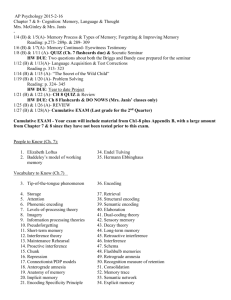
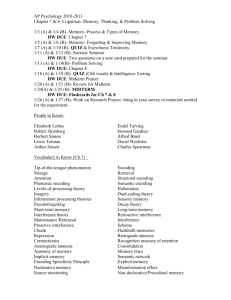
![AP Ch 7 & 8 Assignment Sheet 2011-2012[1]](http://s3.studylib.net/store/data/009480696_1-921fbd18c6c37319dd0619e7ef422ac4-300x300.png)
